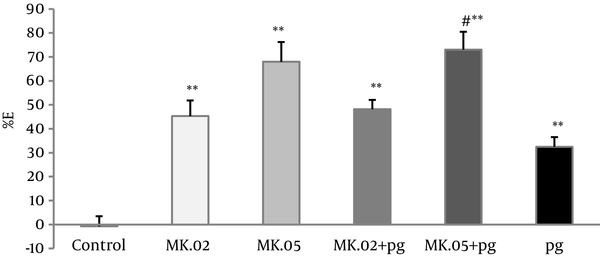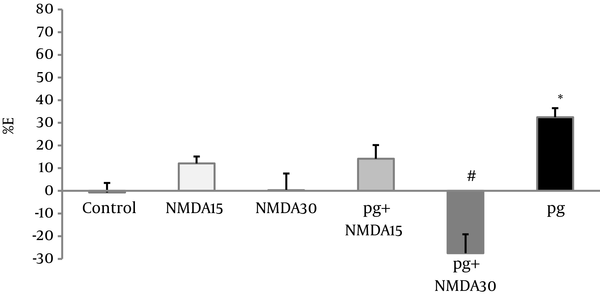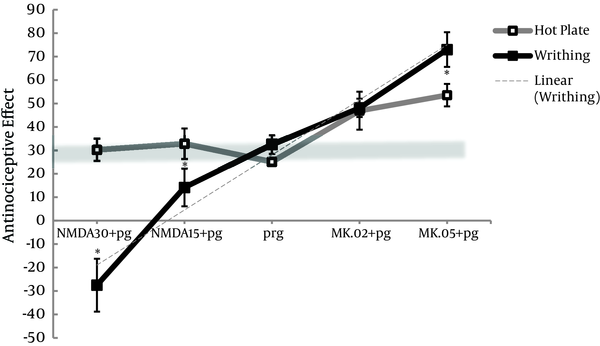Abstract
Background:
Pregabalin has shown remarkable antinociceptive effects in neuropathic pain; however, its efficacy against acute and visceral pain remained controversial.Objectives:
The present study aimed at investigating the involvement of N-methyl-D-aspartate (NMDA) receptors in the antinociceptive effect of pregabalin in both acute and visceral pain using and comparing hot plate test and writhing test in male mice.Methods:
NMDA (15 and 30 mg/kg), as an agonist or MK801 (0.02 and 0.05 mg/kg) as an NMDA receptor (NMDAR) antagonist, were injected intraperitoneally either alone or 15 minutes before a dose of pregabalin that produced almost 30% antinociception (100 mg/kg in hot plate test and 5 mg/kg in writhing tests). Then, the percentage of maximal possible effect (MPE%) at the 30th and 60th minutes in hot plate test and effect percentage (E%) in writhing test were measured and compared as antinociceptive indexes.Results:
In hot plate test, pretreatment with MK801 (0.05 mg/kg) significantly increased antinociceptive effect of 100 mg/kg pregabalin, but pretreatment with NMDA did not result in any effect. Pretreatment with MK801 in writhing test significantly increased the antinociceptive effect of 5 mg/kg pregabalin (In contrast to 30 mg/kg NMDA that significantly decreased it.). NMDA induced antinociception reduction or MK801 increased antinociception in writhing test were significantly higher than what was observed in hot plate test.Conclusions:
Our results suggested that pregabalin antinociception in acute and visceral pain is mediated through NMDA receptors. Although this effect depends on the dose of NMDAR ligand, it is more pronounced in the behavioral response in the writhing test.Keywords
Pregabalin NMDA Antinociception MK801 Writhing test Hot Plate
1. Background
Pain, an unpleasant sensation that may vary in origin, intensity and duration, can be classified into the following types: nociceptive or transient, inflammatory, neuropathic, and functional (1).
Gabapentinoids are a new class of anticonvulsants that offer an exciting therapeutic approach to the treatment of different types of pain (2-4). Pregabalin, a novel anticonvulsant agent, has been evaluated in multiple clinical trials for pain treatment involving peripheral neuropathy, fibromyalgia, and irritable bowel syndrome (2, 3, 5, 6). Although a systemic review of clinical studies denies the effectiveness of pregabalin as analgesic in acute pain treatment (3), several studies have demonstrated its analgesic effect on acute, postoperative pain (7, 8) and in animal models of transient and visceral pain (9-14). Pregabalin is an interesting compound for visceral pain treatments such as irritable bowel syndrome (5). It decreases colonic nociceptive threshold (12) and modulates descending pathway involved in visceral pain transmission (15); the underlying mechanism(s) may be through the contribution of different neurotransmitters and receptors.
NMDA receptors (NMDARs) are known to be involved in pain associated with peripheral tissue or nerve injury (16-20). Continuous activation of NMDARs causes the spinal cord neurons to become more responsive to inputs, leading to the central sensitization component of chronic pain. The other component, which is defined as peripheral sensitization, consists of acquired increased excitability of sensory nerves or a decreased threshold of nociceptor activation (1, 4, 18, 20-22). NMDARs are found in both the enteric nervous system and the peripheral nervous system (23), so peripheral NMDARs become the target of NMDA antagonists, which may act as analgesics (19). In studies on visceral pain, the role of peripheral NMDARs was considered essential in acute nociceptive inputs from viscera (18). Overall, the role of NMDARs in peripheral sensitization and the location of these receptors on afferent somatic and visceral nerve axons suggest a potential approach to pain treatment (18).
2. Objectives
In our previous studies, we found a different antinociceptive potency of pregabalin in tail flick, hot plate, and visceral pain induced by acetic acid (11, 13, 14, 24). The hot plate test assesses acute pain by spinal and supra spinal mechanism and acetic acid induced visceral pain screens both the peripheral and central mechanisms (25). Because the involvement of NMDA receptors has not been determined yet, in this study we aimed at examining the probable involvement of NMDA receptors in pregabalin induced antinociception in acute thermal and visceral pain and determining the difference between hot plate, and writhing test in evaluation of this contribution.
3. Methods
3.1. Animals
Male Swiss albino mice (n = 160), weighing 25 to 35 g were housed 4 or 5 per cage at a controlled temperature (22 ± 2°C) on a 12-hour light-dark cycle. The animals had free access to food and water and were used for only 1 procedure before being humanely killed under anesthesia. The experiments were performed on the light cycle between 8 and 12 AM. The study protocol was approved in March 2011 by the research ethics committee of Kerman University of Medical Sciences (Ka-92/312) in accordance with the National Institutes of Health Guide for Care and Use of Laboratory Animals (Publication No. 85 - 23, revised 1985).
3.2. Drugs
The drugs used included pregabalin (Hetero Drugs Limited, India), N-methyl-D-aspartic acid NMDA (Sigma-Aldrich,USA), and dizocilpine hydrogen maleate MK801 (Sigma-Aldrich, USA). All drugs were freshly dissolved in normal saline and were injected intraperitoneally (i.p.) 15 minutes before pregabalin or normal saline. The acetic acid (Sigma) was dissolved in distilled water.
3.3. Hot Plate Test
The hot plate test assesses the supra spinal response to a thermal noxious stimulus (25). The testing device assesses the antinociceptive effect of drugs by measuring the response latency in the animal. It consisted of an electrically heated surface and an open Plexiglass tube (30 cm high and 20 cm in diameter) to contain the animals. The heated surface was maintained at 55 + 0.5°C. Each animal was smoothly placed on the hotplate. The time before each mouse showed symptoms of feeling pain such as lifting or licking their hind or front paw or jumping out of the cylinder, which occurred very rarely, was measured in seconds and referred to as the hotplate latency time. The reaction time of each animal was tested at least twice before the experiment to exclude those with predrug latencies less than 2 and more than 5 seconds. To prevent injury to the animals, they were removed after a latency time of 15 seconds (cutoff = 15 seconds). The animals were randomly assigned to experimental groups of 6 mice. The latency times were measured once before and at the 30th and 60th minutes after drug injection to determine MPE30% and MPE60%.
3.4. Acetic Acid-Induced Writhing Test
The animals were placed in individual transparent boxes for 30 minutes to adjust to surroundings. Acetic acid 0.6% was prepared freshly. The animal was restrained and exposed ventrally, and an acetic acid at a dose of 10 mL/kg of body weight was injected intraperitoneally (i.p.) in lower right quadrant of abdomen, using insulin syringe at angle 30 grade, dept5 mm. Then, visceral pain was measured by counting the number of writhing reflexes for 30 minutes in experimental groups of 8 mice. The writhing reflexes were characterized by the presence of an abdominal contraction associated with inward outstretching of the hind limbs, a hind paw reflex, or a whole or back body extension. The investigator was blind to the drug injected.
3.5. Procedure
The study comprised of different groups as follow:
1) Control or untreated mice that received normal saline.
2) Pregabalin groups, which received doses of 100 mg/kg or 5 mg/kg, i.p. of pregabalin, according to the type of test (11, 13, 24).
3) MK801 groups that received doses of 0.02 and 0.05 mg/kg, i.p. (MK.02 andMK.05) (13).
4) NMDA groups that received doses of 15 and 30 mg/kg, i.p. (NMDA15 and NMDA30) (13).
5) (pg + MK) groups that received doses of 0.02 and 0.05 mg/kg, i.p. 15 minutes before the injection of pregabalin (pg + MK.02), (pg + MK.05).
6) (pg + NMDA) groups that received doses of 15 and 30 mg/kg, i.p. 15 minutes before the injection of pregabalin (pg + NMDA30), (pg + NMDA15).
In the writhing test, 15 minutes after administration of saline or drugs, acetic acid at 0.6% was administered. Next, the number of abdominal contractions was counted during the 30 minutes of the test administration. The antinociception was quantified as the percent effect in reduction in the number of writhes produced after each dose of the drug was injected: (E%) = [Number of writhes in control - Number of writhes in determined dose / Number of writhes in control] × 100.
In the hot plate assay, the latency times were measured immediately after drug or saline injection, and antinociception was quantified as the percentage of maximal possible effect at the 30th and 60th minutes after drug injection: (MPE30% and MPE60%) = [(T1 - T0)/ T2 - T0)] × 100. T1 was latency time at 30th and 60th minutes after drug administration. T0 and T2 were predrug latency time and cutoff time, respectively.
3.6. Statistical Analysis
Data were expressed as mean ± SEM of 6 mice in the hot plate assay or 8 mice in the writhing test. One-way analysis of variance (ANOVA), followed by Tukey’s test was used to evaluate the significant differences between E% and MPE% among the treated groups. Statistical analysis was conducted using SPSS software Version 15. P < 0.05 was considered statistically significant.
4. Results
4.1. The Effect of NMDARs Ligands Pretreatment on Antinociception of Pregabalin in Hot Plate Test
Our results revealed that both pregabalin (100 mg/kg) and MK801 (0.02 and 0.05 mg/kg), alone and in combination, significantly increased the antinociceptive effect at the 30th and 60th minutes after injection compared with the control group (Figure 1). Also, the MPE60% of coadministration of pregabalin with MK801 (0.02 and 0.05 mg/kg) was significantly higher than pregabalin alone (P < 0.05 and P < 0.005, respectively), but no differences were observed in the MPE30% of these MK801 pretreated group compared with pregabalin alone (Figure 1).
The Antinociceptive Effect of Pregabalin, MK801 and Combination Groups in Hot Plate Test

The MPEs% of NMDA group at doses of 15 and 30 mg/kg showed no significant differences compared with the control group. The MPEs% NMDA pretreated groups (pg + NMDA15 and pg + NMDA30) increased significantly (P < 0.005) compared with the controls, however, no difference was observed in comparison with pregabalin (Figure 2).
The Antinociceptive Effect of Pregabalin, NMDA and Combination Groups in Hot Plate Test

4.2. The Effect of Pretreatment with NMDARs Ligands on Antinociception of Pregabalin in the Acetic Acid Induced Writhing Assay
Pregabalin at 5 mg/kg and MK801 (0.02 and 0.05 mg/kg) reduced the number of abdominal contractions significantly in the acetic acid induced writhing assay compared with the controls (P < 0.005). Moreover, the antinociceptive effect of the pretreated groups with MK801 (pg + MK.02, pg + MK.05) showed a dose-dependent increase compared with the controls (P < 0.005).
The number of abdominal contractions of pretreatment with of MK801 (0.05 mg/kg) in pg + MK.05 group was reduced significantly compared with pregabalin group alone (P < 0.05), however, no difference was observed between pg+MK.02 and pregabalin alone (Figure 3).
The Antinociceptive Effect Produced by Pregabalin, MK801, and Their Combination in the Acetic Acid Writhing Test

NMDA administration (15 and 30 mg/kg) did not produce any significant analgesic effects, but pretreatment of only high dose of NMDA (30 mg/kg) decreased the visceral pain antinociceptive effect of pregabalin (P < 0.001), (Figure 4).
The Antinociceptive Effect Produced by Pregabalin, NMDA, and the Combination in the Acetic Acid Writhing Test

4.3. The Difference Between Hot Plate and Writhing Test in the Assessment of the Effect of NMDAR Ligands on Pregabalin Antinociception
Based on material and methods, the chosen doses of 100 and 5 mg/kg of pregabalin that produced almost 30% of antinociceptive effect in respective hot plate test and writhing test shaped the tick gray line of reference in Figure 5. Antinociceptive effect of pregabalin or NMDA alone was similar between hot plate and writhing test, and no distinct differences were observed in pretreated group of (MK.02 + pg) between the 2 tests (Figure 5). However, MK801 alone produced (P < 0.05) more antinociceptive effect in writhing test (E% = 45.2 ± 6.5 and E% = 68.0 ± 8.2, respectively) compared to hot plate (15.1 ± 1.5 and 29.3 ± 7.1, respectively) (Figures 1 and 3).
The Comparative Interpretation of Antinociceptive Effect Produced by Pregabalin When Pretreated with NMDA and MK801 in the Hot Plate and Writhing Test

When pregabalin was pretreated with 0.05 mg/kg of MK801 (MK.05 + pg), the antinociceptive effect produced in writhing test was significantly increased compared to that produced in hot plate test (P < 0.05). Furthermore, NMDA at both doses (15 and 30 mg/kg) decreased (P < 0.05) the antinociceptive effect of pretreated groups (pg + NMDA15 and pg + NMDA30) in writhing test compared to hot plate (Figure 5).
In writhing test, the pretreatment of high dose of 30 mg/kg of NMDA decreased the antinociception of pregabalin from 30% to -30%, and pretreatment of high dose of 0.05 mg/kg of MK801 increased that effect from 30% to 70%, producing a linear trend model (r2 = 0.964).
5. Discussion
The results of the present study revealed the antinociceptive effect of pregabalin in hot plate and writhing test. MK801, a non-competitive NMDA receptor antagonist, indicated analgesic effect at a dose of 0.05 mg/kg (i.p.). MK801 pretreatment prior to pregabalin significantly increased the analgesic effect of pregabalin compared to controls and pregabalin alone.
We have previously reported the antinociceptive effect of pregabalin in tail flick, hot plate, and acetic acid induced visceral pain (11, 13, 14, 24). In addition, others reported the beneficial effects of pregabalin in inflammatory and neuropathic pain, considering its multimodal analgesic effect (9, 10, 26, 27). Although our results suggest that MK801 posses the analgesic activity in both acute and visceral pain, there are controversial reports on MK801 analgesic activity in acute pain. This controversy depends on dose and the type of pain assessment. In tail flick, same doses of MK801 and NMDA did not have any effect because tail flick test response is a spinal reflex to thermal nociceptive stimulus and probably could measure antinociceptive effect of higher doses (13). Our results are in agreement with those of Nakama-Kitamura and Al-Amin et al. who showed a dose dependent antinociceptive effect of MK801 in hot plate test in mice and rats, respectively (28, 29). Moreover, other investigators reported that MK801 decreased abdominal contractions in acetic acid induced writhing in mice (30) and it abolished the visceral pain induced by noxious and non-noxious stimuli of colorectal distention in rats, indicating that MK801 analgesic activity is mediated through both central and peripheral mechanisms (31, 32). The mediation of NMDARs antagonists on human visceral pain was demonstrated when Ketamine was shown to be more effective in relieving visceral pain than somatic pain (17). Injection of glutamate or NMDA into the rat hind paw produced mechanical hyperalgesia and increased pain behavior to radiant heat (33, 34).
Pretreatment with MK801 significantly increased the antinociception activity of pregabalin in both acute and acetic acid induced visceral pain, indicating the involvement of NMDA receptors in both acute and visceral pain processes. Also, in our previous study, MK801 (0.05mg/kg/i.p.) increased antinociceptive effect of pregabalin in tail flick model of acute pain (13). In agreement to our results, others have reported that systemic administration of NMDAR antagonists including MK801 potentiates the analgesic effect of low doses of morphine in tail flick test (35), and prolongs the morphine analgesic effect in hot plate test (36). Likewise, subanalgesic doses of Ketamine enhanced the antinociceptive effect of morphine in the writhing test (30).
To the best of our knowledge, no study has yet assessed the effect of MK801 (or any other NMDAR antagonist) on pregabalin antinociception in either hot plate or acetic acid induced visceral pain. However, MK801 pretreatment (0.05 mg/kg) produced a synergistic effect on gabapentin antinociception in formalin test in rats without effecting motor coordination (37-39).
The activation of peripheral and central NMDARs is related to different types of pain production and pathways (18). Moreover, NMDA did not change the thermal pain threshold, while injection of glutamate or NMDA into the rat hind paw produced mechanical hyperalgesia and increased pain behavior to radiant heat (33, 34). In another study on NMDAR-knockdown mice, the behavioral responses to thermal nociception (tail flick and hot plate) were unchanged, as opposed to the behavioral response to inflammatory pain, for which significant antinociception was detected (16). Thus, in agreement with our results, these investigations demonstrated the involvement of NMDR in inflammatory, but not transient pain stimulus (18, 40). Accordingly, in our study, MK801 suggested a modest effect of 30% in the hot plate supraspinal integrated response, and a 50% to 70% antinociceptive effect in the writhing test, which represented a central complex response measurement. For that reason, NMDA reduced the antinociceptive effect of pregabalin in writhing test, but not in hot plate test. In the same way, after pretreatment with 30 mg/kg of NMDA, the number of abdominal contractions was reduced in such a way to make negative values of E%, generating a hyperalgesic effect. The development and maintenance of visceral hypersensitivity was previously shown to be NMDA receptor mediated (17). Also, in an inflammatory model of cyclophosphamide-induced visceral cystitis pain, the expression of NMDARs was increased in hypersensitive rats (41).
Involvement of NMDA ligands in antinociception of pregabalin was well- recognized using acetic acid induced abdominal contractions because NMDA pretreatment decreased the analgesic effect of pregabalin in acetic acid induced visceral pain, and MK801 pretreatment increased pregabalin antinociception. Thus, these data suggest that pregabalin antinociception in visceral pain is mediated partly through the involvement of NMDAR on the terminals of primary efferent nerves innervating visceral and colon (2, 4). Pregabalin suppresses spinal hyperactivity via the inhibition of both pre- and post-synaptic NMDARs (42). At the cerebral level of pain perception, pregabalin inhibits stimulus-evoked glutamate release (43). In cell culture studies, pregabalin action depends on NMDA receptor activation and was proposed to act as an indirect antagonist, reducing the levels of intracellular d-serin, a known co-agonist of NMDARs (44, 45).
Our study proposed that inhibition of NMDAR by MK801 results in marked increase in pregabalin antinociception in writhing test (E% = 70), but not in hot plate test. This outcome suggests the involvement of NMDAR in visceral pain nociception through the presence of NMDARs on primary afferent nerve terminals, innervating viscera and the colon (40). Moreover, we have previously reported that ED50 in writhing test is almost 15 times lower than that of hot plate (9, 24). Although pregabalin antinociception in visceral pain could be mediated through NMDA receptors, other mechanism(s) may be involved in pregabalin visceral antinociception including glutaminergic mechanisms (5, 15, 44).
In conclusion, our results proposed the potent antinociceptive effect of pregabalin in acetic acid induced visceral pain and low antinociceptive property in hotplate test. In addition, our results suggested that MK801 significantly increased the pregabalin antinociception in visceral pain through the inhibition of NMDA receptor, indicating that pregabalin antinociception in acetic acid induced visceral pain is at least partly mediated through the involvement of NMDA receptors. Comparison of the writhing and hot plate tests suggested that the writhing test was more appropriate to assess the involvement of NMDARs.
Acknowledgements
References
-
1.
Woolf CJ, American College of P, American Physiological S. Pain: moving from symptom control toward mechanism-specific pharmacologic management. Ann Intern Med. 2004;140(6):441-51. [PubMed ID: 15023710].
-
2.
Gajraj NM. Pregabalin: its pharmacology and use in pain management. Anesth Analg. 2007;105(6):1805-15. [PubMed ID: 18042886]. https://doi.org/10.1213/01.ane.0000287643.13410.5e.
-
3.
Moore RA, Straube S, Wiffen PJ, Derry S, McQuay HJ. Pregabalin for acute and chronic pain in adults. Cochrane Database Syst Rev. 2009;(3). CD007076. [PubMed ID: 19588419]. https://doi.org/10.1002/14651858.CD007076.pub2.
-
4.
Tuchman M, Barrett JA, Donevan S, Hedberg TG, Taylor CP. Central sensitization and Ca(V)alpha(2)delta ligands in chronic pain syndromes: pathologic processes and pharmacologic effect. J Pain. 2010;11(12):1241-9. [PubMed ID: 20472509]. https://doi.org/10.1016/j.jpain.2010.02.024.
-
5.
Gale JD, Houghton LA. Alpha 2 Delta (alpha(2)delta) Ligands, Gabapentin and Pregabalin: What is the Evidence for Potential Use of These Ligands in Irritable Bowel Syndrome. Front Pharmacol. 2011;2:28. [PubMed ID: 21713059]. https://doi.org/10.3389/fphar.2011.00028.
-
6.
Blommel ML, Blommel AL. Pregabalin: an antiepileptic agent useful for neuropathic pain. Am J Health Syst Pharm. 2007;64(14):1475-82. [PubMed ID: 17617497]. https://doi.org/10.2146/ajhp060371.
-
7.
Joshi SS, Jagadeesh AM. Efficacy of perioperative pregabalin in acute and chronic post-operative pain after off-pump coronary artery bypass surgery: a randomized, double-blind placebo controlled trial. Ann Card Anaesth. 2013;16(3):180-5. [PubMed ID: 23816671]. https://doi.org/10.4103/0971-9784.114239.
-
8.
Imani F, Rahimzadeh P. Gabapentinoids: gabapentin and pregabalin for postoperative pain management. Anesth Pain Med. 2012;2(2):52-3. [PubMed ID: 24223337]. https://doi.org/10.5812/aapm.7743.
-
9.
Luszczki JJ. Dose-response relationship analysis of pregabalin doses and their antinociceptive effects in hot-plate test in mice. Pharmacol Rep. 2010;62(5):942-8. [PubMed ID: 21098878].
-
10.
Luszczki JJ, Florek-Luszczki M. Synergistic interaction of pregabalin with the synthetic cannabinoid WIN 55,212-2 mesylate in the hot-plate test in mice: an isobolographic analysis. Pharmacol Rep. 2012;64(3):723-32. [PubMed ID: 22814025].
-
11.
Meymandi MS, Keyhanfar F. Pregabalin antinociception and its interaction with tramadol in acute model of pain. Pharmacol Rep. 2012;64(3):576-85. [PubMed ID: 22814011].
-
12.
Ohashi-Doi K, Gale JD, Kurebayashi Y. Pregabalin inhibits accelerated defecation and decreased colonic nociceptive threshold in sensitized rats. Eur J Pharmacol. 2010;643(1):107-12. [PubMed ID: 20598680]. https://doi.org/10.1016/j.ejphar.2010.06.014.
-
13.
Keyhanfar F, Shamsi Meymandi M, Sepehri G, Rastegaryanzadeh R, Heravi G. Evaluation of Antinociceptive Effect of Pregabalin in Mice and its Combination with Tramadol using Tail Flick Test. Iran J Pharm Res. 2013;12(3):483-93. [PubMed ID: 24250654].
-
14.
Shamsi Meymandi M, Keyhanfar F. Assessment of the antinociceptive effects of pregabalin alone or in combination with morphine during acetic acid-induced writhing in mice. Pharmacol Biochem Behav. 2013;110:249-54. [PubMed ID: 23921185]. https://doi.org/10.1016/j.pbb.2013.07.021.
-
15.
Sikandar S, Dickenson AH. Pregabalin modulation of spinal and brainstem visceral nociceptive processing. Pain. 2011;152(10):2312-22. [PubMed ID: 21778018]. https://doi.org/10.1016/j.pain.2011.06.020.
-
16.
McRoberts JA, Ennes HS, Marvizon JC, Fanselow MS, Mayer EA, Vissel B. Selective knockdown of NMDA receptors in primary afferent neurons decreases pain during phase 2 of the formalin test. Neuroscience. 2011;172:474-82. [PubMed ID: 20974228]. https://doi.org/10.1016/j.neuroscience.2010.10.045.
-
17.
Willert RP, Woolf CJ, Hobson AR, Delaney C, Thompson DG, Aziz Q. The development and maintenance of human visceral pain hypersensitivity is dependent on the N-methyl-D-aspartate receptor. Gastroenterology. 2004;126(3):683-92. [PubMed ID: 14988822].
-
18.
Petrenko AB, Yamakura T, Baba H, Shimoji K. The role of N-methyl-D-aspartate (NMDA) receptors in pain: a review. Anesth Analg. 2003;97(4):1108-16. [PubMed ID: 14500166].
-
19.
Parsons CG. NMDA receptors as targets for drug action in neuropathic pain. Eur J Pharmacol. 2001;429(1-3):71-8. [PubMed ID: 11698028].
-
20.
Bennett GJ. Update on the neurophysiology of pain transmission and modulation: focus on the NMDA-receptor. J Pain Symptom Manage. 2000;19(1 Suppl):S2-6. [PubMed ID: 10687331].
-
21.
Katzung BG. Basic and clinical pharmacology. 10 ed ed. New York: Lang medical books/ Mcgraw-hill; 2007.
-
22.
Liu XJ, White TD, Sawynok J. Intraplantar injection of glutamate evokes peripheral adenosine release in the rat hind paw: involvement of peripheral ionotropic glutamate receptors and capsaicin-sensitive sensory afferents. J Neurochem. 2002;80(4):562-70. [PubMed ID: 11841563].
-
23.
Zhou Q, Nicholas Verne G. NMDA Receptors and Colitis: Basic Science and Clinical Implications. Rev Analg. 2008;10(1):33-43. [PubMed ID: 20574552].
-
24.
Shamsi Meymandi M, Keyhanfar F. Relative potency of pregabalin, gabapentin, and morphine in a mouse model of visceral pain. Can J Anaesth. 2013;60(1):44-9. [PubMed ID: 23132044]. https://doi.org/10.1007/s12630-012-9813-6.
-
25.
Le Bars D, Gozariu M, Cadden SW. Animal models of nociception. Pharmacol Rev. 2001;53(4):597-652. [PubMed ID: 11734620].
-
26.
Kumar N, Laferriere A, Yu JS, Leavitt A, Coderre TJ. Evidence that pregabalin reduces neuropathic pain by inhibiting the spinal release of glutamate. J Neurochem. 2010;113(2):552-61. [PubMed ID: 20132471]. https://doi.org/10.1111/j.1471-4159.2010.06625.x.
-
27.
Rahimzadeh P. Gabapentinoids in pain setting. J Pain Relief. 2013;2(2):114.
-
28.
Al-Amin HA, Saade NE, Khani M, Atweh S, Jaber M. Effects of chronic dizocilpine on acute pain and on mRNA expression of neuropeptides and the dopamine and glutamate receptors. Brain Res. 2003;981(1-2):99-107. [PubMed ID: 12885430].
-
29.
Nakama-Kitamura M. The N-Methyl-D-aspartate receptor antagonist dizocilpine inhibits associative antinociceptive tolerance to morphine in mice: relation with memory. J Pharmacol Sci. 2005;97(1):75-82. [PubMed ID: 15644592].
-
30.
Malec D, Poleszak E. Adenosine receptor ligands and dizocilpine-induced antinociception in mice. Int J Neurosci. 2005;115(4):511-22. [PubMed ID: 15809217]. https://doi.org/10.1080/00207450590519139.
-
31.
Gaudreau GA, Plourde V. Involvement of N-methyl-d-aspartate (NMDA) receptors in a rat model of visceral hypersensitivity. Behav Brain Res. 2004;150(1-2):185-9. [PubMed ID: 15033291]. https://doi.org/10.1016/j.bbr.2003.07.004.
-
32.
Ji Y, Traub RJ. Spinal NMDA receptors contribute to neuronal processing of acute noxious and nonnoxious colorectal stimulation in the rat. J Neurophysiol. 2001;86(4):1783-91. [PubMed ID: 11600639].
-
33.
Zhou S, Bonasera L, Carlton SM. Peripheral administration of NMDA, AMPA or KA results in pain behaviors in rats. Neuroreport. 1996;7(4):895-900. [PubMed ID: 8724668].
-
34.
Lawand NB, Willis WD, Westlund KN. Excitatory amino acid receptor involvement in peripheral nociceptive transmission in rats. Eur J Pharmacol. 1997;324(2-3):169-77. [PubMed ID: 9145768].
-
35.
Nemmani KV, Grisel JE, Stowe JR, Smith-Carliss R, Mogil JS. Modulation of morphine analgesia by site-specific N-methyl-D-aspartate receptor antagonists: dependence on sex, site of antagonism, morphine dose, and time. Pain. 2004;109(3):274-83. [PubMed ID: 15157688]. https://doi.org/10.1016/j.pain.2004.01.035.
-
36.
Bryant CD, Eitan S, Sinchak K, Fanselow MS, Evans CJ. NMDA receptor antagonism disrupts the development of morphine analgesic tolerance in male, but not female C57BL/6J mice. Am J Physiol Regul Integr Comp Physiol. 2006;291(2):R315-26. [PubMed ID: 16601258]. https://doi.org/10.1152/ajpregu.00831.2005.
-
37.
Yoon MH, Bae HB, Choi JI. Antinociceptive interactions between intrathecal gabapentin and MK801 or NBQX in rat formalin test. J Korean Med Sci. 2005;20(2):307-12. [PubMed ID: 15832006]. https://doi.org/10.3346/jkms.2005.20.2.307.
-
38.
Berrino L, Oliva P, Massimo F, Aurilio C, Maione S, Grella A, et al. Antinociceptive effect in mice of intraperitoneal N-methyl-D-aspartate receptor antagonists in the formalin test. Eur J Pain. 2003;7(2):131-7. [PubMed ID: 12600794]. https://doi.org/10.1016/S1090-3801(02)00086-1.
-
39.
Sabetkasaie M, Khansefid N, Ladgevardi MA. Possible role of NMDA receptors in antinociception induced by rilmenidine in mice in the formalin test. Eur J Pain. 2007;11(5):535-41. [PubMed ID: 16934506]. https://doi.org/10.1016/j.ejpain.2006.07.004.
-
40.
McRoberts JA, Coutinho SV, Marvizon JC, Grady EF, Tognetto M, Sengupta JN, et al. Role of peripheral N-methyl-D-aspartate (NMDA) receptors in visceral nociception in rats. Gastroenterology. 2001;120(7):1737-48. [PubMed ID: 11375955].
-
41.
Zhou Q, Price DD, Caudle RM, Verne GN. Spinal NMDA NR1 subunit expression following transient TNBS colitis. Brain Res. 2009;1279:109-20. [PubMed ID: 19406112]. https://doi.org/10.1016/j.brainres.2009.04.038.
-
42.
Tsukamoto M, Kiso T, Shimoshige Y, Aoki T, Matsuoka N. Spinal mechanism of standard analgesics: evaluation using mouse models of allodynia. Eur J Pharmacol. 2010;634(1-3):40-5. [PubMed ID: 20188724]. https://doi.org/10.1016/j.ejphar.2010.02.025.
-
43.
Quintero JE, Dooley DJ, Pomerleau F, Huettl P, Gerhardt GA. Amperometric measurement of glutamate release modulation by gabapentin and pregabalin in rat neocortical slices: role of voltage-sensitive Ca2+ alpha2delta-1 subunit. J Pharmacol Exp Ther. 2011;338(1):240-5. [PubMed ID: 21464332]. https://doi.org/10.1124/jpet.110.178384.
-
44.
Singh NS, Paul RK, Torjman MC, Wainer IW. Gabapentin and (S)-pregabalin decrease intracellular D-serine concentrations in PC-12 cells. Neurosci Lett. 2013;535:90-4. [PubMed ID: 23274708]. https://doi.org/10.1016/j.neulet.2012.12.024.
-
45.
Micheva KD, Taylor CP, Smith SJ. Pregabalin reduces the release of synaptic vesicles from cultured hippocampal neurons. Mol Pharmacol. 2006;70(2):467-76. [PubMed ID: 16641316]. https://doi.org/10.1124/mol.106.023309.